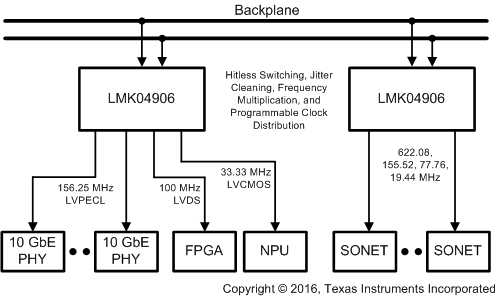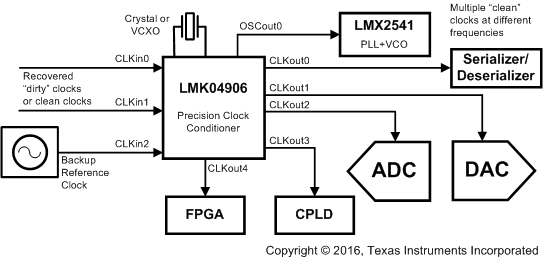SNAS589F June 2012 – August 2017 LMK04906
PRODUCTION DATA.
- 1 Features
- 2 Applications
- 3 Description
- 4 Revision History
- 5 Pin Configuration and Functions
- 6 Specifications
- 7 Parameter Measurement Information
-
8 Detailed Description
- 8.1
Overview
- 8.1.1 System Architecture
- 8.1.2 PLL1 Redundant Reference Inputs (CLKin0/CLKin0*, CLKin1/CLKin1*, and CLKin2/CLKin2*)
- 8.1.3 PLL1 Tunable Crystal Support
- 8.1.4 VCXO/Crystal Buffered Outputs
- 8.1.5 Frequency Holdover
- 8.1.6 Integrated Loop Filter Poles
- 8.1.7 Internal VCO
- 8.1.8 External VCO Mode
- 8.1.9 Clock Distribution
- 8.1.10 0-Delay
- 8.1.11 Default Start-Up Clocks
- 8.1.12 Status Pins
- 8.1.13 Register Readback
- 8.2 Functional Block Diagram
- 8.3
Feature Description
- 8.3.1 Serial MICROWIRE Timing Diagram
- 8.3.2 Advanced MICROWIRE Timing Diagrams
- 8.3.3 Inputs / Outputs
- 8.3.4 Input Clock Switching
- 8.3.5 Holdover Mode
- 8.3.6 PLLs
- 8.3.7 Status PINS
- 8.3.8 VCO
- 8.3.9 Clock Distribution
- 8.3.10 0-Delay Mode
- 8.3.11 Hitless Switching
- 8.4 Device Functional Modes
- 8.5 Programming
- 8.6
Register Maps
- 8.6.1 Register Map and Readback Register Map
- 8.6.2 Default Device Register Settings After Power On Reset
- 8.6.3
Register Descriptions
- 8.6.3.1
Register R0 to R5
- 8.6.3.1.1 CLKoutX_PD, Powerdown CLKoutX Output Path
- 8.6.3.1.2 CLKoutX_OSCin_Sel, Clock Output Source
- 8.6.3.1.3 CLKoutX_ADLX_SEL[29], CLKoutX_ADLX_SEL[28], Select Analog Delay
- 8.6.3.1.4 CLKoutX_DDLY, Clock Channel Digital Delay
- 8.6.3.1.5 Reset
- 8.6.3.1.6 POWERDOWN
- 8.6.3.1.7 CLKoutX_HS, Digital Delay Half Shift
- 8.6.3.1.8 CLKoutX_DIV, Clock Output Divide
- 8.6.3.2 Registers R6 to R8
- 8.6.3.3 Register R10
- 8.6.3.4 REGISTER R11
- 8.6.3.5 Register R12
- 8.6.3.6 Register R13
- 8.6.3.7 Register 14
- 8.6.3.8 Register 15
- 8.6.3.9 Register 16
- 8.6.3.10 Register 23
- 8.6.3.11
Register 24
- 8.6.3.11.1 PLL2_C4_LF, PLL2 Integrated Loop Filter Component
- 8.6.3.11.2 PLL2_C3_LF, PLL2 Integrated Loop Filter Component
- 8.6.3.11.3 PLL2_R4_LF, PLL2 Integrated Loop Filter Component
- 8.6.3.11.4 PLL2_R3_LF, PLL2 Integrated Loop Filter Component
- 8.6.3.11.5 PLL1_N_DLY
- 8.6.3.11.6 PLL1_R_DLY
- 8.6.3.11.7 PLL1_WND_SIZE
- 8.6.3.12 Register 25
- 8.6.3.13 Register 26
- 8.6.3.14 Register 27
- 8.6.3.15 Register 28
- 8.6.3.16 REGISTER 29
- 8.6.3.17 Register 30
- 8.6.3.18 Register 31
- 8.6.3.1
Register R0 to R5
- 8.1
Overview
-
9 Application and Implementation
- 9.1
Application Information
- 9.1.1 Loop Filter
- 9.1.2 Driving CLKin and OSCin Inputs
- 9.1.3 Termination and Use of Clock Output (Drivers)
- 9.1.4 Frequency Planning With the LMK04906 Family
- 9.1.5 PLL Programming
- 9.1.6 Digital Lock Detect Frequency Accuracy
- 9.1.7 Calculating Dynamic Digital Delay Values For Any Divide
- 9.1.8 Optional Crystal Oscillator Implementation (OSCin/OSCin*)
- 9.2 Typical Application
- 9.3 System Examples
- 9.4 Do's and Don'ts
- 9.1
Application Information
- 10Power Supply Recommendations
- 11Layout
- 12Device and Documentation Support
- 13Mechanical, Packaging, and Orderable Information
Package Options
Mechanical Data (Package|Pins)
- NKD|64
Thermal pad, mechanical data (Package|Pins)
- NKD|64
Orderable Information
1 Features
- Ultralow RMS Jitter Performance
- 100-fs RMS Jitter (12 kHz to 20 MHz)
- 123-fs RMS Jitter (100 Hz to 20 MHz)
- Dual Loop PLLatinum™ PLL Architecture
- PLL1
- Integrated Low-Noise Crystal Oscillator Circuit
- Holdover Mode when Input Clocks are Lost
- Automatic or Manual Triggering/Recovery
- PLL2
- Normalized [1 Hz] PLL Noise Floor of –227 dBc/Hz
- Phase Detector Rate up to 155 MHz
- OSCin Frequency-doubler
- Integrated Low-Noise VCO
- PLL1
- 3 Redundant Input Clocks with LOS
- Automatic and Manual Switch-Over Modes
- 50% Duty Cycle Output Divides, 1 to 1045 (Even and Odd)
- LVPECL, LVDS, or LVCMOS Programmable Outputs
- Precision Digital Delay, Fixed or Dynamically Adjustable
- 25-ps Step Analog Delay Control.
- 6 Differential Outputs. Up to 12 Single Ended.
- Up to 5 VCXO/Crystal Buffered Outputs
- Clock Rates of up to 2600 MHz
- 0-Delay Mode
- Three Default Clock Outputs at Power Up
- Multi-mode: Dual PLL, Single PLL, and Clock Distribution
- Industrial Temperature Range: –40 to 85 °C
- 3.15-V to 3.45-V Operation
- Package: 64-Pin WQFN (9 mm × 9 mm × 0.8 mm)
2 Applications
- 10G, 40G, and 100G OTN Line Cards
- SONET/SDH OC-48/STM-16 and OC-192/STM-64 Line Cards
- GbE/10GbE, 1/2/4/8/10GFC Line Cards
- ITU G.709 and Custom FEC Line Cards
- Synchronous Ethernet
- Optical Modules
- DSLAM/MSANs
- Test and Measurement
- Broadcast Video
- Wireless Basestations
- Data Converter Clocking
- Microwave ODU and IDUs for Wireless Backhaul
3 Description
The LMK04906 is the industry's highest performance clock jitter attenuator with superior clock jitter cleaning, generation, and distribution with advanced features to meet high performance timing application needs.
The LMK04906 accepts 3 clock inputs ranging from 1 kHz to 500 MHz and generates 6 unique clock output frequencies ranging from 284 kHz to 2.6 GHz. The LMK04906 can also buffer a crystal or VCXO to generate a 7th unique clock frequency.
The device provides virtually all frequency translation combinations required for SONET, Ethernet, Fibre Channel and multi-mode Wireless Base Stations.
The LMK04906 input clock frequency and clock multiplication ratio are programmable through a SPI interface.
Device Information(1)
| PART NUMBER | VCO FREQUENCY | REFERENCE INPUTS |
|---|---|---|
| LMK04906 | 2370 to 2600 MHz | 3 |
- For all available packages, see the orderable addendum at the end of the data sheet.
System Application Diagram

Simplified LMK04906 Block Diagram
